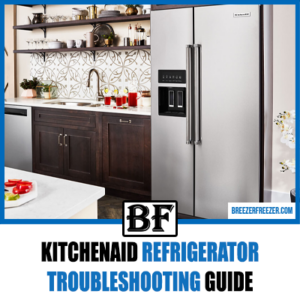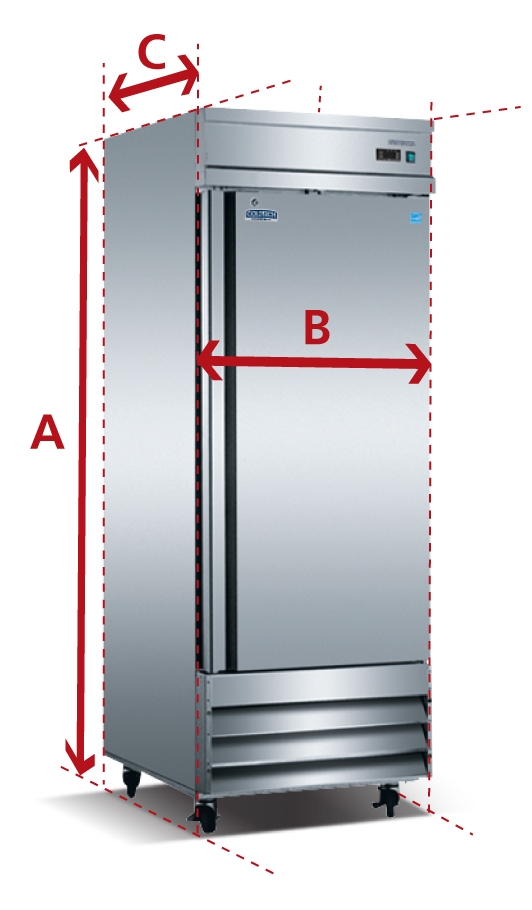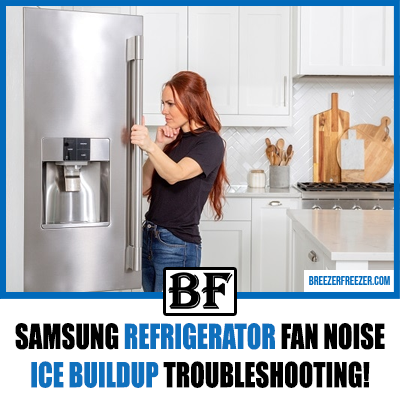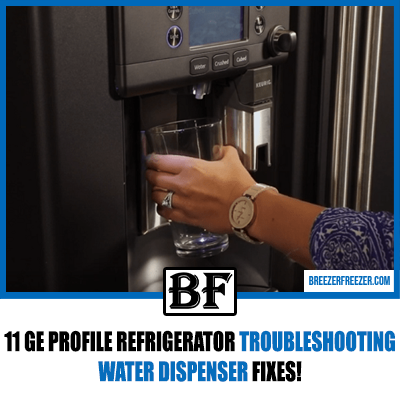Kitchenaid Refrigerator Troubleshooting Guide (6 Problems Fixed!)
KitchenAid is a well-known brand in the refrigerator industry, particularly in the United States. However, like any appliance, KitchenAid fridges can experience issues that require troubleshooting.

In this KitchenAid Refrigerator Troubleshooting guide, we will provide you with the necessary tools to address common problems such as a malfunctioning ice maker, ice dispenser, water dispenser, cooling system, and constant beeping.
Throughout this guide, we will explore the reasons why your KitchenAid refrigerator may encounter these issues and provide step-by-step troubleshooting tips to help you resolve them effectively.
We will address problems such as the ice maker failing to produce ice, the water or ice dispenser not dispensing properly, issues with the defrosting unit, and a refrigerator that fails to cool adequately.
By following the troubleshooting steps outlined in this guide, you will be equipped with the knowledge and techniques to tackle these problems head-on.
Let’s delve into the guide and get your KitchenAid refrigerator back in working order!
| Problem | Probable Cause | Fix |
| Ice Maker Not Making Ice | Ice maker off, high freezer temperature, low water pressure, clogged filter, defective component (water inlet valve, door switch, ice maker switch) | Turn on the ice maker, lower freezer temperature, increase water pressure, unclog filter, and replace defective components or the ice maker |
| Ice Dispenser Not Working | Locked controls, faulty components (auger motor, dispenser switch, door motor) | Unlock controls and replace faulty components |
| Water Dispenser Not Working | Locked controls, frozen water line, low water pressure, clogged water filter, faulty components (water inlet valve, dispenser switch) | Unlock controls, thaw water line, increase water pressure, unclog filter, and replace faulty components |
| Refrigerator Not Cooling | Dirty condenser coils, faulty components (fan motor, thermostat, start relay) | Clean condenser coils and replace faulty components |
| Refrigerator Not Defrosting | Faulty timer, defrost sensor, heater assembly, thermostat, defrost control board | Replace faulty part |
| Refrigerator Beeping | Freezer left open, broken door seal, excess ice, unbalanced fridge | Close freezer, replace door seal, and defrost unit |
Solving the 6 Most Common KitchenAid Refrigerator Problems
If you’re experiencing issues with your KitchenAid refrigerator, here’s a troubleshooting guide to help you address some common problems:
KitchenAid Refrigerator Not Making Ice
If your KitchenAid refrigerator’s ice maker isn’t producing ice, consider the following:
- Ice Maker Could Be Off: Ensure that the ice maker is turned on.
- High Freezer Temperature: The ice maker requires low temperatures to function correctly. Adjust the freezer temperature if it exceeds 10°F.
- Low Water Pressure: Insufficient water pressure can prevent the ice maker from operating. Measure the water pressure with a gauge and adjust it to at least 20 psi if necessary. Unblock the water supply line.
- Clogged Filter: A clogged water filter can impede water flow to the ice maker. Replace the filter every six months.
- Defective Water Inlet Valve: Test the water inlet valve using a multimeter. Replace it if it’s faulty.
- Faulty Door Switch or Ice Maker Switch: Test these switches with a multimeter and replace any that show no continuity.
- Ice-Level Control Board Failure: A faulty control board may fail to signal the ice maker to produce ice. Replace the control board if necessary.
- Defective Ice Maker: Consider replacing the ice maker if all other troubleshooting steps fail.
Unit Not Dispensing Ice
If your KitchenAid refrigerator’s ice maker produces ice but doesn’t dispense it, consider the following:
- Locked Controls: Check if the “Control Lock” function is engaged. Turn it off to unlock the ice dispenser.
- Faulty Components: Examine the auger motor, dispenser switch, door motor, actuator dispenser solenoid, ice crusher, and ice bucket auger for faults. Replace any defective components.
KitchenAid Refrigerator Not Dispensing Water
If the water dispenser on your KitchenAid refrigerator isn’t working, consider the following:
- Locked Controls: Ensure the “Control Lock” function is turned off to unlock the water dispenser.
- Frozen Water Line: Check for ice blockages in the water line. Turn off the unit to allow it to self-defrost.
- Low Water Pressure: Measure the water pressure with a gauge and adjust it to at least 20 psi if necessary.
- Clogged Water Filter: Replace the water filter if it’s been in use for more than six months or is clogged.
- Faulty Water Inlet Valve, Dispenser Switch, Door Switch, or Dispenser Control Board: Test these components with a multimeter and replace any that are defective.
KitchenAid Refrigerator Not Cooling
If your KitchenAid refrigerator fails to cool, consider the following:
- Dirty Condenser Coils: Clean the condenser coils with a condenser coil cleaning brush.
- Faulty Components: Check the fan motor, thermostat, start relay, thermistor, compressor, temperature control board, and main control board for faults. Replace any defective components.
KitchenAid Refrigerator Not Defrosting If your KitchenAid refrigerator isn’t defrosting, consider the following:
- Faulty Timer: Replace the defrost timer if it’s defective.
- Faulty Defrost Sensor: Replace the defrost sensor if it fails to monitor the evaporator temperature.
- Heaters Assembly Failure: Replace the heater assembly if it fails to melt frost.
- Defective Thermostat: Replace the thermostat to reactivate the defrost heater.
KitchenAid Refrigerator Not Defrosting
If your KitchenAid refrigerator fails to defrost, there are several potential causes to consider:
- Faulty Timer A defective defrost timer can prevent the refrigerator from entering the defrost cycle. If this is the case, replacing the defrost timer is necessary.
- Faulty Defrost Sensor When the defrost sensor is faulty, it fails to monitor the evaporator temperature, resulting in a defrosting issue. Replacing the defrost sensor is recommended.
- Heater Assembly Failure If the heater assembly is faulty, it will be unable to melt frost properly. If there is an accumulation of frost on the evaporator coil, it indicates a defective heater assembly that needs to be replaced.
- Defective Thermostat A defective thermostat can hinder the functioning of the defrost heater. In such cases, replacing the thermostat will restore power to the defrost heater.
- Defrost Control Board or Main Control Failure If all other components, including the timer, sensor, thermostat, and heater assembly, are in working order, a malfunctioning defrost control board or main control board may be the cause. In such instances, replacing the faulty control board is necessary.
KitchenAid Refrigerator Beeping
If your KitchenAid refrigerator is beeping, the following factors could be the cause:
- The Door Has Been Open for A Long Time If the refrigerator door has been left open for more than 5 minutes, simply closing the door will stop the beeping.
- Broken Door Seal A broken door seal allows air to escape, triggering the beeping sound. Consider replacing the damaged door seal to resolve the issue.
- KitchenAid Refrigerator Not Making Ice If your KitchenAid refrigerator is not producing ice, consider the following possibilities:
- Excess Ice Excessive ice accumulation indicates a failed defrosting process, resulting in the refrigerator producing a beeping sound. To address this, turn off the unit and allow it to self-defrost.
- Unbalanced Fridge If the refrigerator is unstable, it may beep as a result. To stop the beeping, try stabilizing the fridge by changing its location or adjusting its feet for proper leveling.
- Recent Power Loss After a power outage, a KitchenAid refrigerator may emit a few beeps and display “power outage” on the control panel. Simply pressing any button on the control panel will stop the beeping.
KitchenAid Refrigerator Water Filter Reset
Resetting the water filter can help in resetting the entire refrigerator unit. To do this, press and hold the water filter or filter reset button for 8-10 seconds, and then release it before restarting the fridge.
Manual KitchenAid Refrigerator Reset
For this reset method, unplug the refrigerator from the power source and leave it unplugged for 10 minutes. Afterward, plug it back in and restart the fridge normally.
It’s important to note that resetting the fridge can often clear any troubleshooting codes that may be causing issues.
Conclusion
You now have a quick guide for troubleshooting common KitchenAid refrigerator problems. While the six issues mentioned above are the most common, there may be other problems that can occur.
If you encounter any other issues not covered in this guide, refer to your KitchenAid manual or contact a refrigerator technician for assistance.





